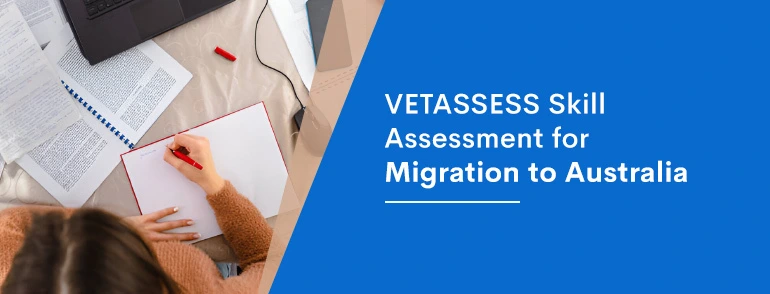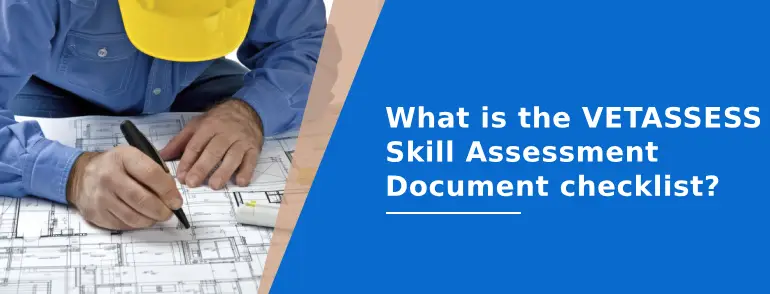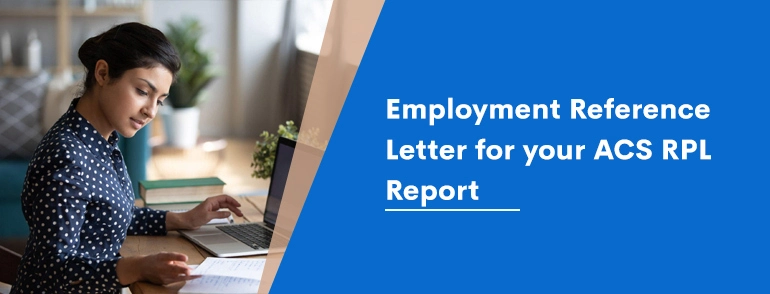If you’re considering migrating to Australia and want to work in a skilled occupation, one of the essential steps you’ll need to take is the VETASSESS skill assessment. VETASSESS (Vocational Education and Training Assessment Services) is an Australian assessing authority responsible for evaluating the qualifications and work experience of individuals wishing to migrate to Australia. This assessment ensures that your skills meet Australian standards, a crucial requirement for skilled migration visas.
A good skill assessment from VETASSESS is the key to opening your door to temporary employment prospects or permanent residency in Australia, regardless of your profession—engineering, trades, accounting, information technology, or pharmaceuticals.
This blog layout provides a more in-depth examination of the VETASSESS skill assessment process, including who must take to undergo it and whether you can negotiate the requirements to maximise your chances of succeeding.
Stay tuned as we walk you through the steps of VETASSESS and help you start down the path to your Australian goal!
What is a VETASSESS Skill Assessment?
VETASSESS (Vocational Education and Training Assessment Services) is an Australian organisation that provides skill assessments for individuals seeking to migrate to Australia.
The skill assessment is a critical part of the Australian skilled migration process, designed to evaluate whether an applicant’s qualifications, skills, and work experience align with Australian standards for a particular occupation.
VETASSESS is one of the authorised assessing authorities under Australia’s skilled migration programme; its role is to ensure that skilled migrants possess the appropriate skills and qualifications for their nominated occupation.
The outcome of this assessment plays a significant role in determining eligibility for various types of Australian visas, such as the Skilled Independent Visa (subclass 189) and Skilled Nominated Visa (subclass 190).
Learn more: How to Handle VETASSESS feedback?🤩🙀🥳
Objectives of VETASSESS Skill Assessment
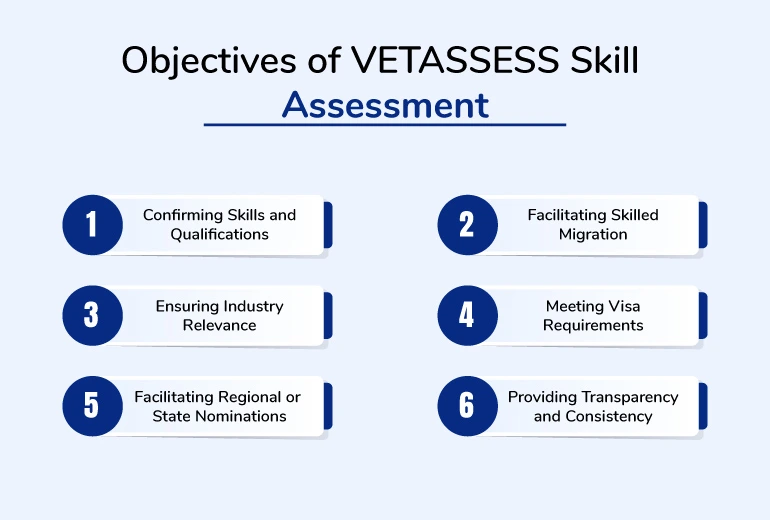
The objectives of the VETASSESS skill assessment are to evaluate whether an individual’s qualifications, work experience, and professional skills meet the standards required for a particular occupation in Australia.
Some of the objectives are listed below:
1. Confirming Skills and Qualifications
The primary purpose of the VETASSESS skill assessment is to verify that an individual’s qualifications and work experience match the Australian standards for a specific occupation.
This is essential because Australia’s immigration system depends on skilled workers to fulfil the requirements of the labour market. VETASSESS ensures that candidates possess the necessary skills and experience to perform the work required in their nominated occupation.
2. Facilitating Skilled Migration
A positive VETASSESS assessment is required for individuals who wish to apply for skilled migration to Australia. Many Australian visa subclasses, including for permanent residency, require applicants to submit a successful skills assessment.
It is one of the first steps in the application process, as it establishes whether an individual’s background aligns with Australian requirements for a skilled worker.
3. Ensuring Industry Relevance
The skill assessment ensures that applicants have qualifications and work experience that are recognised and equivalent to Australian standards. By evaluating a candidate’s credentials, VETASSESS ensures that the person is qualified and their skills are relevant and transferrable to the Australian job market.
This helps maintain the quality and integrity of the Australian workforce.
4. Meeting Visa Requirements
For many skilled migration visas, such as the Skilled Independent Visa (subclass 189) and Skilled Nominated Visa (subclass 190), a positive skills assessment is a mandatory requirement.
This assessment helps immigration authorities determine whether a candidate is suited for a specific role and whether they can contribute to the Australian economy. Without a positive skills assessment, candidates will not be eligible to apply for these visas.
5. Facilitating Regional or State Nominations
In addition to the general skilled migration process, VETASSESS plays a role in regional and state-nominated visa pathways. Some Australian states and territories nominate skilled workers based on specific needs, and VETASSESS helps assess whether the applicant’s qualifications and skills meet those regional or state requirements.
6. Providing Transparency and Consistency
The VETASSESS skill assessment provides a standardised and transparent process for determining an applicant’s eligibility for skilled migration.
By conducting an impartial and thorough review of qualifications and work experience, VETASSESS helps ensure that all applicants are evaluated based on the same criteria, leading to fairer and more consistent decision-making.
What are the documents required for a VETASSESS Skill Assessment?
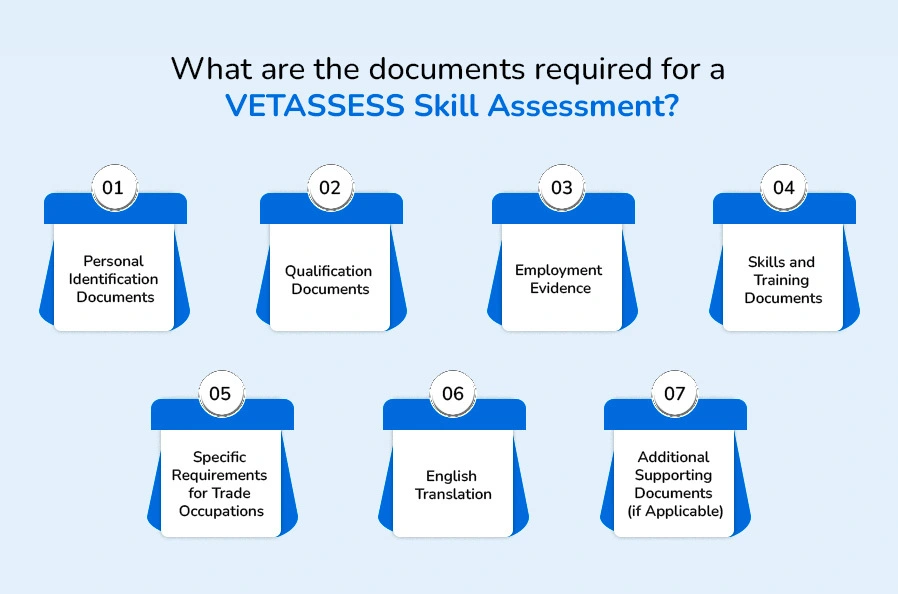
If you intend to migrate to Australia through a skilled migration visa, your first crucial step could be a VETASSESS skill assessment.
As one of Australia’s leading skills assessment authorities, VETASSESS analyses your qualifications, work experience, and skills to make sure they align with Australian standards. To make your application process seamless, it’s crucial to understand the documents required.
The documents required for a VETASSESS skill assessment are given below:
1. Personal Identification Documents
Your identity is the key element of the application.
Ensure you have:
- Passport
A clear, scanned copy of the bio-data page of your current passport.
- Proof of Name Change (if applicable)
Documents include a marriage certificate, divorce decree, or a legal name change certificate.
2. Qualification Documents
Your educational background is an important factor in determining your eligibility for the nominated occupation. These include:
- Degree or Diploma Certificates
Official certificates for each qualification (e.g., bachelor’s, master’s, diplomas).
- Academic Transcripts
A detailed record of the subjects studied and grades achieved for each qualification.
- Syllabus
Occasionally, VETASSESS may request a course syllabus to verify the relevance of your studies to the nominated occupation.
3. Employment Evidence
Proving your professional experience is crucial, especially for skilled migration. The required documents are as follows:
a. Employer Reference Letters
These should be written on official company letterhead and include:
The employer’s name and contact details.
Your job title(s) and detailed job description(s).
Start and end dates for each role.
Your work hours (full-time or part-time).
b. Pay Slips or Tax Records
To confirm your employment duration and income.
c. Employment Contracts
Outline your terms of employment, such as roles, responsibilities, and salary.
d. Statutory Declarations
If you are self-employed or unable to provide reference letters, you can submit statutory declarations signed by supervisors or colleagues.
4. Skills and Training Documents
You may be required to demonstrate specific skills or training for certain occupations. Examples include:
- Certificates of completion for vocational training programmes.
- Membership in professional organisations or industry certifications.
5. Specific Requirements for Trade Occupations
If your occupation falls under the trades category, additional documents may be necessary, such as:
- Evidence of practical skills training related to your trade.
- Trade licences or registration (if applicable).
- Work portfolios showcase completed projects or installations.
6. English Translation
All documents must be in English. If your documents are in another language:
- Use a professional, accredited translator for translations.
- Submit both the original documents and the translated copies.
7. Additional Supporting Documents (if Applicable)
Depending on your circumstances, you may also need:
- Proof of volunteer work or unpaid professional experience.
- Letters or statements from colleagues confirming your employment details (if reference letters are unavailable).
What are the benefits of VETASSESS Skill Assessment?
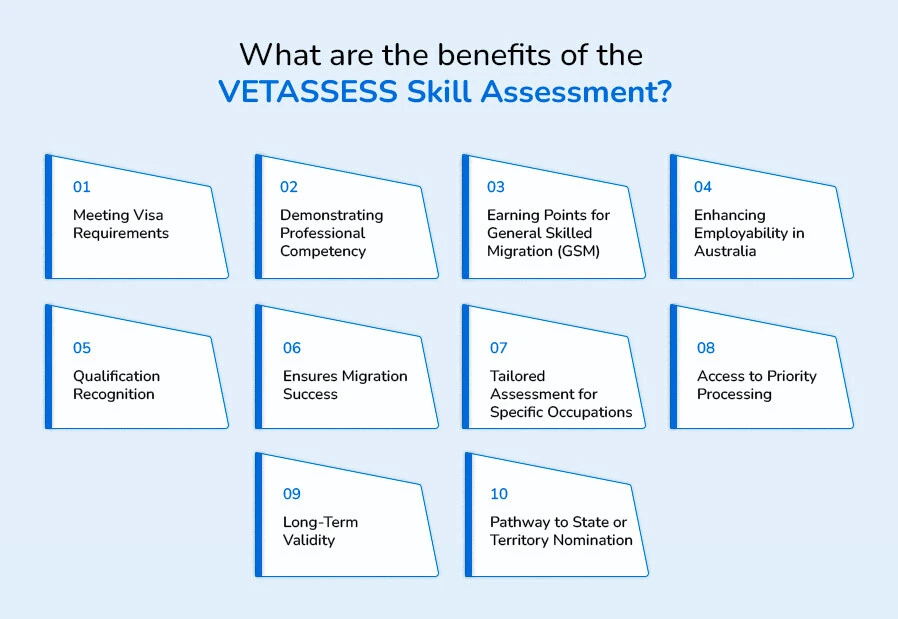
The VETASSESS skill assessment offers several benefits for individuals seeking to migrate to Australia under skilled migration programmes.
It plays a crucial role in ensuring that applicants’ qualifications and experience meet Australian standards and are well-prepared for the migration process.
Here are the key benefits of experiencing a VETASSESS skill assessment
1. Meeting Visa Requirements
- A positive skills assessment is mandatory for many skilled migration visas, such as the Skilled Independent Visa (subclass 189), Skilled Nominated Visa (subclass 190), and Skilled Regional Visa (subclass 491).
- VETASSESS ensures that you meet the eligibility requirements of your nominated occupation, enabling you to apply for these visas.
2. Demonstrating Professional Competency
- The assessment validates your qualifications and work experience, proving your skills are comparable to Australian standards.
- It ensures you are qualified to perform the duties required for your nominated occupation in Australia.
3. Earning Points for General Skilled Migration (GSM)
- A successful VETASSESS assessment allows you to claim points for qualifications and work experience under the General Skilled Migration points test.
- The more points you earn, the higher your chances of receiving an invitation to apply for a visa.
4. Enhancing Employability in Australia
- The VETASSESS assessment confirms your skills to Australian employers, increasing your credibility in the local job market.
- For trade workers, practical assessments demonstrate hands-on skills, making it easier to secure employment upon arrival.
5. Qualification Recognition
- If you hold qualifications from overseas, VETASSESS ensures they are assessed for equivalency to Australian educational standards.
- This recognition may be useful not only for migration, but also for licencing, registration, or further education in Australia.
6. Ensures Migration Success
- The comprehensive assessment process minimises the risk of rejection by verifying your documents and ensuring you meet the migration requirements.
- By resolving discrepancies or gaps in your qualifications or work experience early, the assessment helps smooth your migration journey.
7. Tailored Assessment for Specific Occupations
- VETASSESS offers assessments for general and trade occupations, ensuring people from various professional backgrounds can demonstrate their skills effectively.
- Specialised pathways such as the Offshore Skills Assessment Programme (OSAP) or DAMA Skills Assessments cater to specific needs, increasing flexibility for applicants.
8. Access to Priority Processing
- Applicants can opt for priority processing, which expedites the assessment, reducing waiting times and allowing you to proceed with your visa application more quickly.
9. Long-Term Validity
- A positive VETASSESS skills assessment is typically valid for three years, giving you ample time to complete your visa application and plan your migration.
10. Pathway to State or Territory Nomination
- A VETASSESS assessment can be used to apply for state or territory nomination, often required for certain skilled visas like subclass 190 or 491.
- It demonstrates to Australian states or territories that your skills are in demand in their region.
VETASSESS Skill Assessment fee
VETASSESS, the Australian Government-authorised skills assessment authority, evaluates qualifications and work experience for individuals seeking skilled migration to Australia. The fees for these assessments vary based on the occupation type and specific assessment requirements.
a. Professional Occupations
For applicants applying from within Australia, the fees are as follows:
| Full Skills Assessment (Qualifications and Employment) |
|
| Priority Processing Fee |
|
For applicants applying from outside Australia, the fees are:
| Full Skills Assessment (Qualifications and Employment) |
|
| Priority Processing Fee |
|
b. Trade Occupations
For trade occupations, the assessment is conducted in stages, each with its fee:
| Documentary Evidence Assessment |
|
| Technical Interview |
|
| Practical Assessment |
|
c. Recent Fee Adjustments
Effective November 20, 2024, VETASSESS increased application fees for professional and general occupation assessments in line with inflation. For instance, the price for a Full Skills Assessment for professional occupations increased from AUD 1,033 to AUD 1,070.
Types of VETASSESS Skill Assessment

The types of VETASSESS skill assessments change based on the occupation category and the specific requirements of the Australian migration program. VETASSESS primarily serves two major occupation categories.
General Occupations and Trade occupations, with further subdivisions based on the nature of the assessment.
1. General Occupations Skill Assessment
This type of assessment is for professionals and para-professionals in non-trade fields such as management, education, healthcare, and social services.
Subcategories for General Occupations
- Full Skills Assessment
Includes both qualification and employment verification to ensure the applicant meets the requirements of the nominated occupation.
- Qualification-Only Assessment
Assesses academic qualifications without verifying employment experience. This option is useful for licensing or recognition purposes.
- Employment-Only Assessment
Evaluates work experience for those with substantial employment history but without formal qualifications.
2. Trade Occupations Skill Assessment
For skilled workers in trade fields like construction, mechanics, and hospitality. This assessment often includes practical components in addition to document verification.
Stages of Trade Occupations Assessment
a. Documentary Evidence Assessment
Verification of qualifications and employment history through submitted documents.
b. Technical Interview
A structured interview was conducted by a qualified assessor to evaluate technical knowledge and skills.
c. Practical Assessment
Hands-on testing to demonstrate practical abilities is required for some trade occupations.
3. Offshore Skills Assessment Program (OSAP)
Designed for applicants in trade occupations who acquired their skills outside Australia. This programme ensures that their qualifications and experience meet Australian standards.
4. Points Test Advisory Service
This service provides an advisory letter indicating how an applicant’s qualifications and employment align with the Australian General Skilled Migration (GSM) points test.
5. Priority Processing Assessment
Available for both general and trade occupations, this service expedites the assessment process for applicants who need results quickly.
Know more: Common mistakes to avoid in a VETASSESS skill assessment application🤔💭😕
Conclusion
The VETASSESS Skill Assessment is an essential step in the journey to skilled migration in Australia. By understanding the process, preparing the necessary documents, and ensuring your skills align with Australian standards, you’ll be well on your way to building a successful future in one of the most dynamic countries in the world.
You can make a big step towards realising your Australian migration ambition by being aware of the many kinds of evaluations, carefully completing the necessary paperwork, and matching your requirements with those of your chosen profession.
A positive VETASSESS outcome not only fulfils visa requirements but also enhances your employability and credibility in Australia. As the gateway to skilled migration, VETASSESS is your trusted partner in transforming your aspirations into reality.
FAQs
1. How long does it take for a VETASSESS Skill Assessment?
The VETASSESS skill assessment usually takes 8–10 weeks for standard processing, or 2–3 weeks with priority processing. Times may vary based on document completeness and application complexity.
2. How do I get positive skill assessments from VETASSESS?
To receive positive skill assessments from VETASSESS, you should:
- Select the Right Occupation
- Prepare Documents
- Apply Online
- Meet Standards
- Follow Up
3. How long is a VETASSESS skill assessment valid for?
A VETASSESS skill assessment is valid for three years. After that, if you’re still applying for migration, you may need a new assessment or renewal.
4. Does VETASSESS require IELTS?
VETASSESS does not require IELTS for the skill assessment, but you may need it to meet the English language requirement for your visa application. It is separate from the VETASSESS process itself.
5. Does VETASSESS conduct interviews?
Yes, VETASSESS may conduct interviews for certain trade occupations to assess practical skills and knowledge. For some professions, a suitable assessment may also be required. However, interviews are typically not needed for most professional occupations unless specified.

